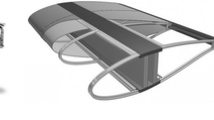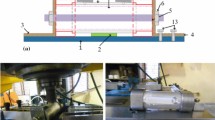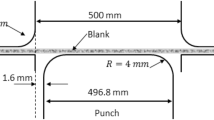Abstract
One approach to design load optimized structures is the use of bifurcations. Linear flow splitting is a continuous sheet-bulk metal forming process, whereby bifurcated profiles are manufactured without joining or external heat supply. By roll forming linear flow split profiles, a wide spectrum of profile geometries can be realized, e.g. multi-chamber-profiles. Those profiles often require high dimensional accuracy to ensure their functionality. During roll forming, process related residual stresses are induced, which are released when the profiles are cut to length. Thereby increased deformation at the profile ends occurs, also known as end flare. End flare of bifurcated profiles has not been investigated so far. The aim of this research is to investigate end flare after roll forming of linear flow split profiles. Therefore, end flare after roll forming of a conventional sheet metal and a linear flow split profile is compared. The effect of residual stresses induced by linear flow splitting as well as the effect of additional geometrical stiffness due to the bifurcations on the development of end flare are examined. It is found that the residual stresses induced by linear flow splitting have no significant effect on end flare. However, the geometrical bifurcation affects the roll forming process, leading to higher residual stresses in the flange, which significantly affect the magnitude and the direction of end flare.



















Similar content being viewed by others
References
Groche P, Bruder E, Gramlich S (2017) Manufacturing integrated design – sheet metal product and process innovation, Springer international publishing AG
Groche P, Ringler J, Vucic D (2007) New forming processes for sheet metal with large plastic deformation. Key Eng Mater 344:251–258
Groche P, Vucic D, Jöckel M (2006) Basics of linear flow splitting. J Mater Process Technol 183:249–255
Groche P, Vucic D (2006) Multi-chambered profiles made from high-strength sheets. Production Engineering, Annals of the WGP 3:67–70
Halmos G (2005) Roll forming handbook. CRC Press, Boca Raton
Sweeney K, Grunewald U (2003) The application of roll forming for automotive structural parts. J Mater Process Technol 132(1-3):9–15
Moneke M, Groche P (2017) Counter measures to effectively reduce end flare, AIP Conference Proceedings 1896, pp. 020006–1 – 020006–6
Lange K (1990) Handbook of metal forming – volume 3, Society of Manufacturing Engineers
Zhu S, Panton S, Duncan J (1996) The effects of geometric variables in roll forming a channel section. Proceedings of The Institution of Mechanical Engineers Part B-journal of Engineering Manufacture - PROC INST MECH ENG B-J ENG MA 210(2):127–134
Abeyrathna B, Rolfe B, Hodgson P, Weiss M (2017) Local deformation in roll forming. Int J Adv Manuf Technol 88(9–12):2405–2415
Bhattacharyya D, Smith P, Yee C, Collins I (1984) The prediction of deformation length in cold roll-forming. J Mech Work Technol 9(2):181–191
Abeyrathna B, Rolfe B, Weiss M (2017) The effect of process and geometric parameters on longitudinal edge strain and product defects in cold roll forming. Int J Adv Manuf Technol 92(1–4):746–754
Paralikas J, Salonitis K, Chrydssolouris G (2009) Investigation of the effects of main roll forming process parameters on quality for a V-section profile from AHSS. Int J Adv Manuf Technol 44(3–4):223–237
Han Z, Liu C, Lu W, Ren L (2001) The effects of forming parameters in the roll-forming of a channel section with an outer edge. J Mater Process Technol 116(2-3):205–210
Saffe S, Nagamachi T, Ona H (2015) Mechanism of end deformation after cutting of light Gauge Channel steel formed by roll forming. Mater Trans 56(2):187–192
Quach W, Teng J, Chung K (2004) Residual stresses in steel sheets due to coiling and uncoiling - a closed-form analytical solution. Eng Struct 26(9):1249–1259
Weiss M, Abeyrathna B, Rolfe B, Abee A, Wolfkamp H (2017) Effect of coil set on shape defects in roll forming steel strip. J Manuf Process 25:8–15
Weiss M, Rolfe B, Hodgson P, Yang C (2012) Effect of residual stress on the bending of aluminium. J Mater Process Technol 212(4):877–883
Abvabi RB, Hodgson P, Weiss M (2015) The influence of residual stress on a roll forming process. Int J Mech Sci 101-102:124–136
Ludwig C, Hammen V, Groche P, Kaune V, Müller C (2013) Manufacturing of quality optimized linear flow split parts by variation of fast modifiable process parameters and their influence on material characteristics. Mat-wiss u Werkstofftech 44(7):601–611
Groche P, Monnerjahn V, Özel M, Yu Y (2017) Remote joining by plastic deformation in the process of linear flow splitting. J Mater Process Technol 246:262–266
Görtan M, Vucic D, Groche P, Livatyali H (2009) Roll forming of branched profiles. J Mater Process Technol 209(17):5837–5844
Bruder E, Ahmels L, Niehuesbernd J, Müller C (2017) Manufacturing-induced material properties of linear flow split and linear bend split profiles. Mat-wiss u Werkstofftech 48(1):41–52
Liu C, Zhou W, Fu X, Chen G (2015) A new mathematical model for determining the longitudinal strain in cold roll forming process. Int J Adv Manuf Technol 79(5–8):1055–1061
Görtan O, Ludwig C, Groche P, Livatyali H (2009) Finite Element Simulation of Roll Forming Process of Branched Profiles, 5th International Conference and Exhibition on Design and Production of Machines and Dies/Molds, 18–21 June 2009, Kusadasi, Aydin, Turkey
Wagner C, Gramlich S, Monnerjahn V, Groche P, Kloberdanz H (2015) Technology pushed process and product innovation – joining by linear flow splitting. Procedia CIRP 37:83–88
Monnerjahn V, Lobers M, Groche P (2017) Simultaneous Forming and Joining by Linear Flow Splitting – From Basic Mechanisms to the Continuous Manufacturing Line, Procedia Engineering, Vol. 207, pp. 962–967
Rullmann F, Abrass A, Kruse M, Groche P (2012) The Cut-Expand-Method for the FE-simulation of steady-state rolling processes, Metal Forming. Wiley-VCH Verlag GmbH & Co., Weinheim, Germany
Rullmann F, Bauer O, Landersheim V, Groche P, Hanselka H (2012) Numerische durchgängige Prozessketten- bewertung mittels FEM, in 4. Zwischenkolloquium des Sonderforschungsbereich 666:109–120
Müller C, Bohn T, Bruder E, Bruder T, Landersheim V, Dsoki C, Groche P, Veleva D (2007) Severe plastic deformation by linear flow splitting. Mat-wiss u Werkstofftech 38(10):842–854
Bruder E, Bohn T, Müller C (2008) Properties of UFG HSLA Steel Profiles Produced by Linear Flow Splitting. Mater Sci Forum 584–586:661–666
Acknowledgements
The investigations presented in this paper are supported by the German Research Foundation (DFG). The authors would like to thank DFG for funding the Collaborative Research Centre 666 “Integral sheet metal design with higher order bifurcations – Development, Production, Evaluation”.
Funding
This study was funded by the German Research Foundation (DFG) as part of Collaborative Research Center 666 (CRC 666).
Author information
Authors and Affiliations
Corresponding author
Ethics declarations
Conflict of interest
The authors declare that they have no conflict of interest.
Additional information
Publisher’s Note
Springer Nature remains neutral with regard to jurisdictional claims in published maps and institutional affiliations.
Publisher’s Note
Springer Nature remains neutral with regard to jurisdictional claims in published maps and institutional affiliations.
Rights and permissions
About this article
Cite this article
Moneke, M., Mahajan, P. & Groche, P. End flare of linear flow split profiles. Int J Mater Form 12, 429–440 (2019). https://doi.org/10.1007/s12289-018-1426-3
Received:
Accepted:
Published:
Issue Date:
DOI: https://doi.org/10.1007/s12289-018-1426-3




